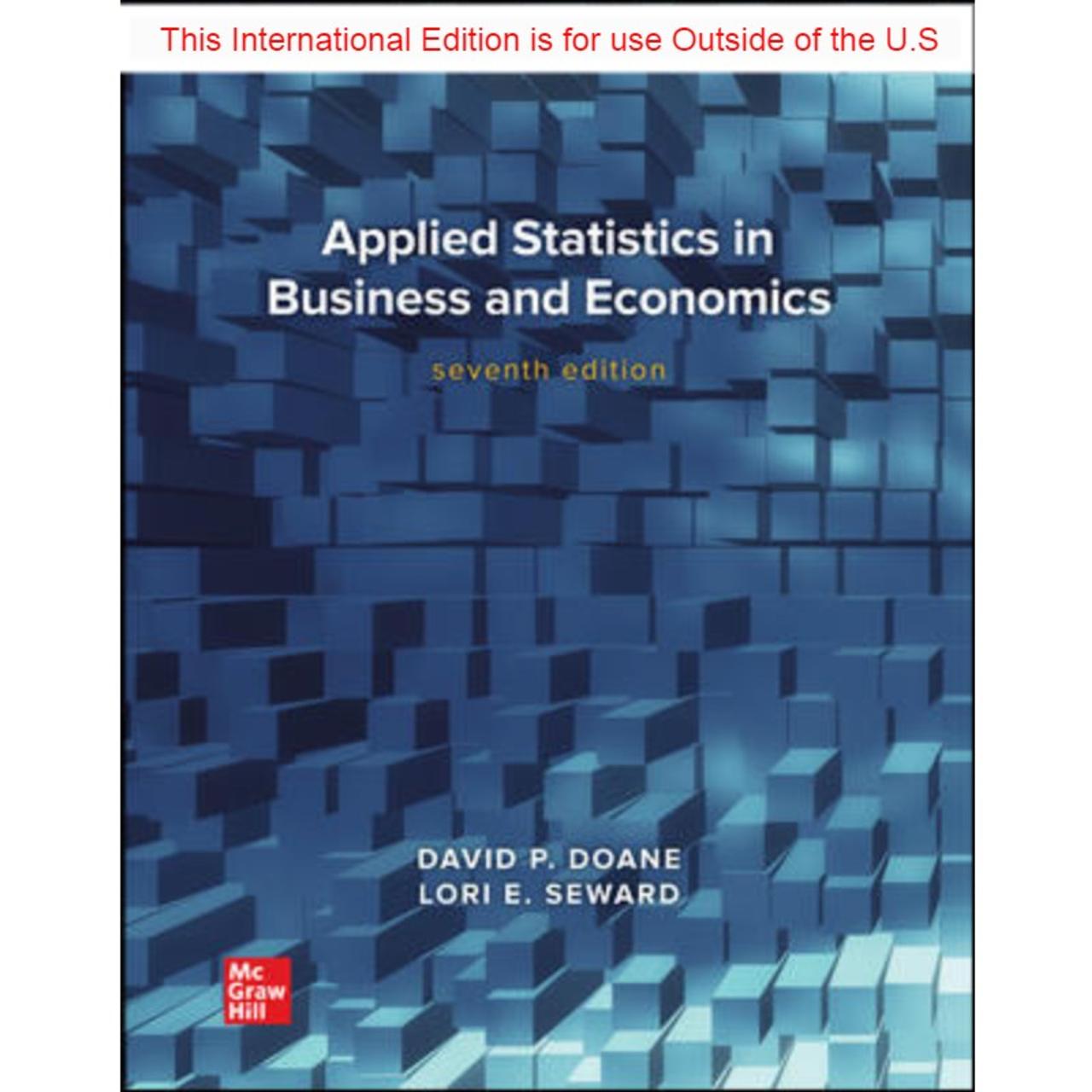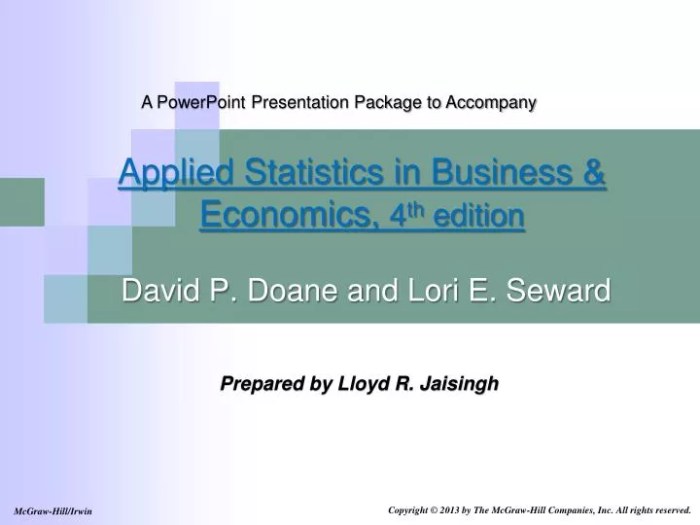Applied Statistics in Business and Economics Doane PDF provides a comprehensive exploration of the significance of statistics in driving informed decision-making and shaping economic forecasts. Through a blend of theoretical concepts and practical examples, this resource equips readers with the knowledge and skills to harness the power of data in the business and economic realms.
In today’s data-rich environment, applied statistics has become an indispensable tool for businesses and economists alike. By leveraging statistical methods, organizations can gain valuable insights into consumer behavior, market trends, and economic indicators, enabling them to make data-driven decisions that drive growth and profitability.
1. Applied Statistics in Business and Economics: Applied Statistics In Business And Economics Doane Pdf
Applied statistics plays a pivotal role in the decision-making process within business and economics. It provides a framework for analyzing data, drawing inferences, and making informed decisions. By utilizing statistical methods, organizations can gain valuable insights into market trends, customer behavior, and economic indicators, enabling them to optimize operations, enhance strategies, and mitigate risks.
Examples of Statistics in Business Decision-Making
- Predicting demand for new products based on market research data
- Analyzing customer feedback to identify areas for improvement
- Forecasting economic growth based on historical trends and economic indicators
- Determining the effectiveness of marketing campaigns through A/B testing
- Optimizing inventory levels to minimize costs and maximize customer satisfaction
Benefits of Using Statistics in Economic Forecasting
- Improved accuracy in predicting economic trends
- Enhanced understanding of economic relationships and drivers
- Identification of potential risks and opportunities
- Support for policy-making and resource allocation
- Provision of evidence-based decision-making
2. Statistical Methods for Data Analysis
Data analysis is essential for extracting meaningful insights from data. Applied statistics provides a wide range of statistical methods tailored to different types of data and research questions.
Types of Statistical Methods
- Descriptive statistics: Summarizing and presenting data in a concise and informative manner
- Inferential statistics: Drawing conclusions about a larger population based on a sample
- Regression analysis: Modeling the relationship between a dependent variable and one or more independent variables
- Time series analysis: Analyzing data collected over time to identify patterns and trends
- Cluster analysis: Grouping similar observations into clusters
Advantages and Disadvantages of Statistical Methods
| Method | Advantages | Disadvantages |
|---|---|---|
| Descriptive statistics | Simple to understand and interpret | Limited in providing insights beyond data summarization |
| Inferential statistics | Allows for generalization to a larger population | Relies on assumptions that may not always be met |
| Regression analysis | Predicts the value of a dependent variable based on independent variables | Can be sensitive to outliers and requires careful model selection |
| Time series analysis | Identifies patterns and trends in time-dependent data | Can be complex to interpret and requires specialized knowledge |
| Cluster analysis | Groups similar observations together | Can be subjective and the choice of clustering algorithm affects results |
Examples of Statistical Methods in Practice
- Using descriptive statistics to summarize customer demographics in a marketing survey
- Conducting inferential statistics to test the effectiveness of a new product launch
- Applying regression analysis to predict sales based on advertising spending
- Utilizing time series analysis to forecast economic growth
- Performing cluster analysis to identify different customer segments based on purchase history
3. Data Visualization and Interpretation

Data visualization is a powerful tool for communicating insights from data analysis. It allows users to quickly and easily understand complex relationships and patterns.
Importance of Data Visualization
- Facilitates data exploration and discovery
- Enhances understanding of data patterns and trends
- Supports decision-making by providing a clear visual representation of data
- Improves communication and presentation of findings
Types of Data Visualization Techniques
- Charts: Bar charts, line charts, pie charts
- Graphs: Scatterplots, histograms
- Maps: Geographic visualizations
- Dashboards: Interactive visualizations combining multiple data sources
- Infographics: Visual representations of complex data
Examples of Data Visualization, Applied statistics in business and economics doane pdf
- A line chart showing the trend in sales over time
- A bar chart comparing the market share of different companies
- A scatterplot showing the relationship between customer satisfaction and product price
- A geographic map showing the distribution of sales across different regions
- An infographic summarizing key findings from a market research study
4. Statistical Modeling and Forecasting
Statistical modeling is the process of creating a mathematical representation of a real-world phenomenon. It allows for prediction and forecasting based on historical data.
Process of Statistical Modeling
- Data collection and preparation
- Model selection and estimation
- Model evaluation and validation
- Prediction and forecasting
Types of Statistical Models
- Linear regression models
- Nonlinear regression models
- Time series models
- Machine learning models
Examples of Statistical Models
- A linear regression model to predict sales based on advertising spending
- A nonlinear regression model to predict customer churn
- A time series model to forecast economic growth
- A machine learning model to identify fraudulent transactions
5. Applications of Applied Statistics in Business and Economics

Applied statistics finds widespread applications across various business sectors and economic policy-making.
Applications in Business
- Finance: Risk management, portfolio optimization
- Marketing: Market research, customer segmentation
- Operations: Inventory management, quality control
- Human resources: Employee selection, performance evaluation
Applications in Economics
- Economic forecasting: GDP growth, inflation
- Monetary policy: Interest rate setting
- Fiscal policy: Government spending and taxation
- Labor market analysis: Employment trends, wage growth
Role of Statistics in Economic Policy-Making
- Provides evidence-based support for policy decisions
- Identifies economic trends and risks
- Evaluates the effectiveness of policy interventions
- Supports long-term economic planning
6. Ethical Considerations in Applied Statistics
The use of statistics in business and economics involves ethical considerations to ensure responsible and unbiased data analysis.
Potential for Bias and Misuse
- Data manipulation and selective reporting
- Misleading visualizations and interpretations
- Ignoring uncertainty and limitations
Guidelines for Ethical Statistical Practice
- Transparency in data collection and analysis methods
- Objectivity in data interpretation and reporting
- Awareness of potential biases and limitations
- Respect for privacy and confidentiality
- Adherence to professional ethical codes
FAQ Explained
What is the significance of applied statistics in business?
Applied statistics provides businesses with the tools and techniques to analyze data, draw meaningful conclusions, and make informed decisions. It enables them to understand customer behavior, optimize marketing campaigns, forecast demand, and improve operational efficiency.
How is applied statistics used in economic forecasting?
Applied statistics is essential for economic forecasting as it allows economists to analyze historical data, identify trends, and develop models to predict future economic outcomes. These forecasts are crucial for policymakers, businesses, and investors in making informed decisions.
What are the ethical considerations involved in using applied statistics?
When using applied statistics, it is important to consider ethical implications such as data privacy, bias, and misuse of statistics. Researchers and practitioners must adhere to ethical guidelines to ensure the integrity and responsible use of statistical methods.